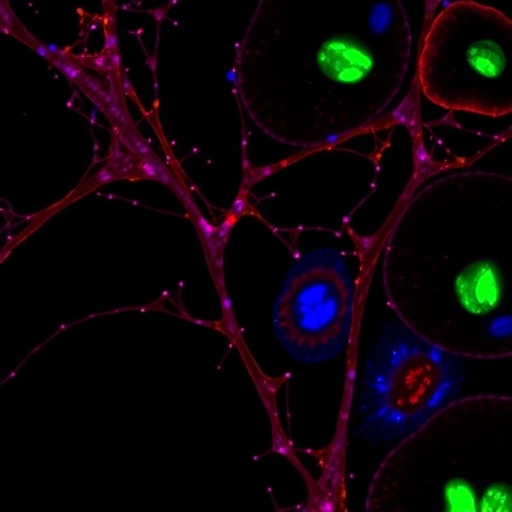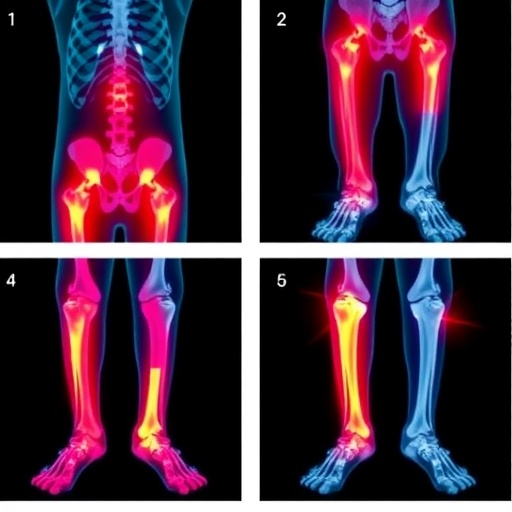In the complex landscape of cancer biology, phosphorylation-driven signaling pathways stand out as critical regulators of cellular behavior, often tipped out of balance during tumorigenesis. At the heart of this regulatory network lies the mitogen-activated protein kinase (MAPK) pathway, a fundamental conduit that orchestrates cell proliferation, differentiation, and survival. Aberrations in MAPK signaling have long been implicated in various cancers, underscoring the urgency to decipher mechanisms that govern its activity and to develop novel strategies for therapeutic intervention.
A recent breakthrough study published in BMC Cancer sheds new light on the modulation of MAPK signaling by revealing how oncogenic microRNAs govern the expression of a pivotal negative regulator: dual specificity phosphatase 2 (DUSP2). DUSP2 acts as a critical brake on the MAPK cascade by dephosphorylating and inactivating key kinases, thereby maintaining cellular homeostasis. However, this intricate negative feedback loop appears compromised in cancer, contributing to unchecked pathway activation and fueling malignancy.
The investigative team implemented an integrative approach, combining computational in silico analyses with empirical data from pan-cancer cohorts, to identify microRNAs that may directly target and repress DUSP2. Their comprehensive examination spanned 32 diverse cancer types, uncovering robust inverse correlations between DUSP2 mRNA levels and members of oncogenic microRNA clusters—specifically, the miR-17-92, miR-106a-363, and miR-106b-25 clusters. These findings illuminate a widespread mechanism through which microRNAs potentially disrupt MAPK pathway regulation across multiple malignancies.
.adsslot_LA8ejpJB5I{ width:728px !important; height:90px !important; }
@media (max-width:1199px) { .adsslot_LA8ejpJB5I{ width:468px !important; height:60px !important; } }
@media (max-width:767px) { .adsslot_LA8ejpJB5I{ width:320px !important; height:50px !important; } }
ADVERTISEMENT
To validate these predictions, the researchers employed reporter gene assays, a sensitive and precise technique to confirm microRNA binding to the 3’ untranslated region (3’UTR) of target mRNAs. This experimental setup substantiated that a suite of microRNAs—including miR-17-5p, miR-20a-5p, miR-20b-5p, miR-29b-3p, miR-93-5p, miR-106b-5p, miR-122-5p, miR-340-5p, miR-520a-3p, and miR-520c-3p—interact directly with the 3’UTR of DUSP2, affirming the regulatory role suggested by bioinformatic data.
Moving beyond in vitro binding assays, the team probed the functional consequences of inhibiting select microRNAs within a lymphoma cell model. Treatment with inhibitors targeting miR-17-5p, miR-20b-5p, and miR-106b-5p resulted in a significant elevation of DUSP2 mRNA expression, demonstrating that these microRNAs exert suppressive pressure on DUSP2 transcript levels in a cellular environment. Such modulation parallels a potential reactivation of the negative feedback checkpoints within the oncogenic MAPK signaling pathway.
The implication of these results extends well beyond a single cancer type. The identified microRNA clusters are notorious for their oncogenic roles, contributing to tumorigenesis by regulating multiple targets involved in cell cycle control, apoptosis avoidance, and metastasis. Their newfound connection to DUSP2 suggests that dysregulated microRNA activity may broadly impair the fine-tuning of MAPK-driven oncogenic signaling, promoting an environment conducive to cancer progression.
This discovery is particularly pertinent given the limitations of current kinase inhibitor therapies. Although effective in certain contexts, these drugs often meet resistance due to compensatory signaling and feedback loops that circumvent blockade. Targeting microRNA-mediated suppression of negative regulators like DUSP2 heralds a novel strategy to restore the balance of MAPK activity, potentially overcoming resistance and improving therapeutic outcomes.
Moreover, this study underscores the emerging paradigm that microRNAs are not mere bystanders but active architects in cancer signaling circuits, capable of modulating crucial negative feedback regulators. By controlling phosphatases such as DUSP2, oncogenic microRNAs amplify kinase-driven signaling, further engraining malignant phenotypes. This adds a layer of complexity to our understanding of cancer signaling networks, emphasizing the importance of post-transcriptional gene regulation.
Given these insights, future research avenues arise. It will be critical to delineate how microRNA-mediated DUSP2 suppression influences downstream MAPK pathway components and cellular phenotypes like proliferation, invasive potential, and therapeutic response. Additionally, broader profiling of microRNA-DUSP2 interactions across more cancer contexts may reveal subtype-specific vulnerabilities amenable to precision medicine approaches.
The ramifications of these findings are compelling for the field of molecular oncology. MicroRNA-based therapeutics have garnered interest for their ability to modulate gene networks, yet have faced challenges in delivery and specificity. The identification of miR-17-92, miR-106a-363, and miR-106b-25 clusters as key regulators of DUSP2 provides a focused target constellation for designing microRNA inhibitors or mimics that could recalibrate disrupted signaling pathways in cancer.
Furthermore, the interplay between microRNAs and phosphatases invites a reevaluation of traditional kinase-centric drug development pipelines. Integrative targeting of both kinases and their phosphatase regulators may represent a more effective tactic to achieve durable responses in MAPK-driven tumors. Such combinatorial approaches could circumvent redundancies and escape mechanisms that tumors exploit.
In clinical settings, assessing expression profiles of these microRNA clusters alongside DUSP2 levels could serve as biomarkers for disease prognosis or treatment stratification. Patients exhibiting pronounced microRNA-mediated DUSP2 repression might benefit from tailored regimens incorporating microRNA-based therapeutics, potentially enhancing responsiveness to MAPK inhibitors or other targeted agents.
This investigation marks a significant step towards unraveling the multi-layered regulation of MAPK signaling in cancer. By illuminating how oncogenic microRNA clusters co-opt phosphatase regulators like DUSP2, the research enriches our molecular map of tumor biology, highlighting vulnerabilities ripe for exploitation. As the field advances, the translation of these insights into clinical paradigms holds the promise to transform cancer treatment landscapes.
Ultimately, the control of cellular signaling hinges on a delicate equilibrium between activating kinases and inhibitory phosphatases. Disruption of this balance by oncogenic microRNAs uncovers a subtle yet powerful mechanism conspiratorially driving cancer progression. The elucidation of microRNA-DUSP2 regulatory axes fuels optimism that therapeutic modulation of post-transcriptional networks could unlock new frontiers in oncology care.
Subject of Research: Regulation of the MAP kinase pathway in cancer through microRNA-mediated suppression of the negative regulator DUSP2.
Article Title: The MAP kinase negative regulator DUSP2 (dual specificity phosphatase 2) is controlled by oncogenic microRNA cluster miR-17-92, miR-106a-363 and miR-106b-25.
Article References:
Tenhaken, V., Seternes, O.M., Cascorbi, I. et al. The MAP kinase negative regulator DUSP2 (dual specificity phosphatase 2) is controlled by oncogenic microRNA cluster miR-17-92, miR-106a-363 and miR-106b-25. BMC Cancer 25, 1020 (2025). https://doi.org/10.1186/s12885-025-14434-z
Image Credits: Scienmag.com
DOI: https://doi.org/10.1186/s12885-025-14434-z
Tags: cancer types and microRNAscellular homeostasis in malignancycomputational analysis in cancer researchdual specificity phosphatase 2DUSP2 regulation in cancerempirical studies in oncologyMAPK signaling pathwaynegative feedback in cancer biologyoncogenic microRNAsphosphorylation-driven signalingtherapeutic intervention strategiestumorigenesis mechanisms





